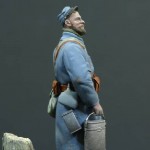
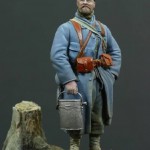
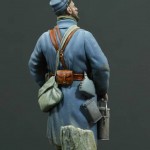
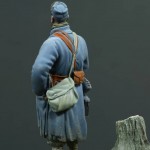
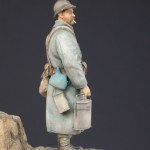
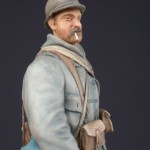
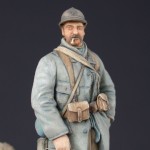
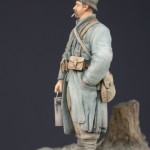
French Infantryman, 318th Inf, Regt., Verdun, 1918
- Scale / Maßstab: 54mm
- Material: Resin, Model Plaster / Modell-Gips (synethetische, kunststoffveredelte Gießmasse)
- Parts / Teile: 13
- Infosheet / Infoblatt: English
- Code: 19PO
Contents / Inhalt:
- Figure (3 parts) / Figur (3 Teile)
- Alternative Head / 2. Kopf
- 3 x Ammunition Pouches M1916 / Patronentaschen M1916
- Gas Mask M2 / Gasmaskenbehälter M2
- Haversack M1892 / Brotbeutel M1892
- Canteen M1877 / Feldflasche M1877
- Group Canteen Bouteillon / Gruppenkochgeschirr Bouteillon
- Emblem
- Figure Base (Model Plaster) / Sockel
The Figure: French Infantryman 1918
The figure depicts a dishevelled great-coated French Infantryman having just come out of the front line near Verdun, early 1918. He shows the typical appearance of the Poilu at this late stage of the war. Absent of cause are the distinctive turned up coat flaps, so much more evident in early war photos. As in 1914 and typical of the French Army most of his equipment is still being hung around the neck as opposed to being attached to the leather belt and brace equipment.
Head No. 1: He wears the Adrian helmet at a slightly offset angle, pushed to the back of the head. The long drooping down moustache and 2-3 days without shaving gives a somewhat scruffy appearance. If required, one can drill out at side of the mouth and fix a piece of the copper wire supplied to make the cigarette.
Head No. 2: This second head with this figure has more of the `tradition´ look of an older Poilu, with the typical, fashionable full beard of the time. The grey Kepi M1914, with dark blue piping and an untrimmed black leather visor at the front appeared during the first winter of 1914/15 and was to replace the blue M1884 kepi, although all types of headdress were worn simultaneously throughout the war. In some photos, regimental numbers are to be seen sewn onto the front of the kepi. The black leather chinstrap is fastened on each side of the kepi with brass buttons. Above these are the two black metal ventilation holes.
Uniform
Cotton Neck Cloth: Around the neck can be seen the issued blue cotton neck cloth. The colours of these cloths varied from dark navy blue pre-war types, to light-blue, grey-blue late war versions.
Service Tunic M1914/15: On the figure underneath the belt and between the unbuttoned greatcoat can just be seen parts of the service tunic M1914/15. Normally the greatcoat was the regular combat uniform of the French Army and the tunic would only be worn in the warm months of summer. However, in cold conditions, a combination of both greatcoat and tunic were worn together giving a somewhat bulky appearance. Colour: horizon-blue (could well have been a lighter shade).
Private Pullover: Next to the service tunic and also between the unbuttoned greatcoat can be seen parts of a non-regulation pullover. This is quite a normal practice, particularly for front-line troops who always wore a combination of official and unofficial clothing, regardless of nation.
Greatcoat M1914/15: The figure wears the M1914/15 horizon blue greatcoat, which apart from a few changes, took on the appearance of the original M1877 coat in style. It had a turned down collar with grey-blue painted metal buttons at the front and smaller ones on the pockets. The figure is wearing none of the detachable shoulder straps (these could be rolled up at the end in the French style to avoid the rifle sling from slipping off when on the march). The bottom left and rear side of the coat has been ripped and torn. On each side of the greatcoat were 2 large reinforced (from the inside) pockets for the carrying of extra ammunition. The pockets flaps were held down with smaller buttons and in many cases were added after the initial issue of the coat, so that quite often a colour difference in the material would be seen.
The dark-blue 318 sewn-on regimental patch on the collar (the other one cannot be seen) has been modelled slightly raised to enable an easier paint finish.
The colour of these greatcoats varied considerably and depended a lot on the dye used, origin, wear and tear and age of the garment. On the greatcoat itself, the structure and fold of the creases follows the standard form copied from various photos of French troops in the field. It is always better when gathering reference material to use original photos of troops who have been actually wearing their uniforms over long periods of time, as most garments (as indeed all types of clothing, depending on the material used) will crease and fold in roughly the same way. Some reference books, especially for collectors of uniforms are helpful for colour-reference and information etc., but will not always portray an accurate picture of how the uniforms appeared after many days and weeks of being worn.
Service Dress Trousers M1914: Made out of a blue-grey material, with sometimes a thin yellow stripe running down each side. Here again different items varied considerably in colour, but on many original photos appear to be of a darker shade than the greatcoat.
Puttees M1902: An Indian word meaning bandages. In the French Army the puttee was originally the sign of the Chasseurs Alpins, who had worn them since 1889. Designed to cover the gap between boot and trousers, keeping the lower leg warm and dry. The French issue puttee was approx. 2.60m long, 12cm wide and was sometimes worn in a criss-cross pattern in order to avoid the gaps, which invariably happened after constant use. The figure as in the original photo sports short puttees. Colour: grey-blue.
Boot M1912: The M1912 boot, or field shoe was made out of brown leather, with the rough side outwards. Later, the M1916 modifide boot (only issued in large numbers from the end of 1917) had a higher shaft.
Equipment
Adrian Helmet M1915: The Adrian helmet, similar to the fireman, or dragoon helmet of the period, first appeared in sufficient numbers for the Champagne offensive in September 1915. By December 1915 a total of 3 million had been produced. Weighing only 765 gram and formed from relatively mild steel it did not give as much protection as its German and British counterparts. On the front is the grenade of the infantry (this would differ according to the arm of the service). Colour: the first helmets to be introduced had a shiny blue-grey finish, which by December 1915 were being covered with a khaki cloth cover. From the summer 1916 the helmets were issued in a blue-grey matt colour and being worn without the cloth covers again (to avoid the cloth, which was never clean being dragged into head wounds). The chinstrap was brown leather, with a steel buckle on the left side. The wearing of the chinstrap over the top of the front helmet rim was a very popular practice and is seen on many original photos of French troops of the time.
Leather Belt and Brace Equipment M1892/1914: The only difference from the early pre-war equipment was that since December 1914 all belts, braces and straps etc. were issued in natural tan brown, instead of black. The M1903 belt has a double spike/thorn buckle.
Ammunition Pouches M1916: The 3 brown leather M1916 pouches were designed to hold 5 packets with 8 rounds of 8mm cartridges and were attached with the aid of a tin-plated iron suspension ring and hooks (early versions had brass hooks) to the brace (yoke) equipment. A brass stud at the front held the pouch flap down.
Gas Mask M2: The M2 gas mask was stowed in a metal tin. (In accordance to French Army regulation this should be attached to the left ammunition pouch by means of a string cord – on the figure it is attached underneath the canteen). This mask entered service in April 1916 and consisted of a multi-layered cloth bag with eye-pieces. Colour: the tins varied in colour from grey-blue to khaki. Often the edges were chipped and worn from constant use so that the bare metal could be seen.
Note: The string attachment cord (I used thin copper wire) should be added after the construction of figure / painting is completed.
Canteen M1877: The supply of drinking water to troops spending ever-increasing periods in front line areas was not always easy. From 1915 the 2-litre water bottle, originally designed for African service, was issued to the troops. Covered using the blue cloth-material from the no longer issued greatcoat M1877 and laced together with a leather cord at the side. The canteen had 2 distinctive spouts; the larger of the 2 was sealed with a cork stopper (plug), the top part fixed with a metal cap and loop. The other spout used a small wooden peg stopper. Both stoppers (sometimes the cup as well) were attached to the leather strap fasteners by a length of cord. Underneath the canteen, in the middle was a white sewn-on name-label – 30 x 62 mm (in 1/32 scale 1 x 2mm). The name-label was important, as canteens could not always be individually replenished, but collection together by detailed personnel or working parties. The French Army regulation for the carrying of the water bottle was on the right side, behind the arm, with the smaller of the 2 spouts pointing forward.
Haversack M1892: Made out cotton with a herringbone weave sling, which went around the outside of the bag for added strength. Two unpainted steel buttons fastened the flap. (On the figure one of the fastening buttons has been replace by a safety pin). Apart from his daily rations, other items to be found were: spoon; fork; issued pocketknife; tin opener; washing and shaving kit: sewing kit, spare ammunition and anything else they good cram in it. These haversacks were dyed in a red-brown colour officially known as cachou, but sometimes varied considerably from grey-green to light and brown-khaki.
Bayonet M1886/93: The correct position for the bayonet was on the left side and was often hidden from view by the folds of the greatcoat. The handle was of polished steel and the sheath was black.
Group Canteen Bouteillon: The Bouteillon (named after the official responsible for the issue of this item – Boutheon) was an aluminium boiler with lid designed to heat up the rations for the whole squad – normally a dozen men. Colour: grey.
A piece of wire is supplied in order to form the carrying handle. A slight indent has been modelled on the greatcoat to aid the fixing of the canteen to the figure.
The Emblem: The emblem can be used to decorate the base, or wooden plinth after the figure has been finished. It depicts the grenade of the infantry from the front of the Adrian helmet. The letters RF stand for Republique France.
The Base: The base supplied with the figure depicts a piece of muddy ground with various small puddles of rainwater from a resent shower. The torn trunk is all that is left from a shattered tree. The severed branches, bracken and brambles have all long disappeared through the constant shelling; leaving exposed the subsoil and tree roots. Small puddles have now appeared, leaving the ground wet and muddy. The colour of the soil in this area is light brown-beige with small stones. The trees were of a mixed variety.
 An deutschsprachige Interessenten:
Sie können mich per eMail oder Telefon auch gerne auf deutsch kontaktieren. Ortsbesuch ist nach Absprache möglich.
An deutschsprachige Interessenten:
Sie können mich per eMail oder Telefon auch gerne auf deutsch kontaktieren. Ortsbesuch ist nach Absprache möglich.
